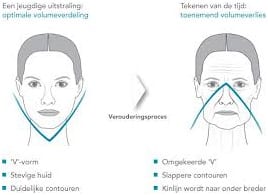Why a facelift, brow or neck lift?
Facelift surgery, or a rhytidectomy, is designed to restore a more youthful appearance by removing major wrinkles and sagging skin. It involves tightening of the facial and neck muscles as well as the removal of any excess skin.
The skin begins to wrinkle and sag as a result of age, sun exposure and genetics. Children and young adults have smooth, round faces due to evenly distributed fatty tissues in facial contours. Over time, the skin sags and folds in the chin, jawline and neck become prominent.
Not only does a facelift improve facial appearance but also has a dramatic effect on the neck, enhancing its contour and profile. During the initial consultation, your plastic surgeon may ask you to look in a mirror and point out exactly what you would like to see improved.
Sometimes, patients may focus their attention on excess skin in the upper eyelids and not realize that sagging of their eyebrows contributes to this skin redundancy.
You should be very frank in discussing anything about your appearance that bothers you, as well as what you hope to achieve with surgery. This will help your surgeon to understand your expectations and determine whether they can realistically be achieved.
Your procedure in Belgium; Which facelift?
The SMAS and MACS facelifts are the most commonly performed techniques used today, although a number of other techniques have also been developed and have their fans.
Apart from that there are other lifts : Subperiosteal , Midface, SOOF , neck (platysmaplasty) lifts are have their place.
It is probably safe to say that there is no obvious “best technique” on which surgeons agree. According to statistics from the American Society for Aesthetic Plastic Surgery (ASAPS), over 138,000 Americans had facelift surgery in 2007 to help reduce the appearance of loose skin and wrinkles around the cheeks and neck area.
Facelifts are usually performed under a general anaesthetic, although a local anaesthetic along with a sedative to make you drowsy can also be used, so that you remain awake but feel very little discomfort during the surgery. Although there are many variations to the facelift procedure, generally an incision is hidden in the natural contour of your ear, then extends around the earlobe and back into the hairline.
Following surgery, incisions can be easily concealed by your hair or with makeup. Through the discreet facelift incisions, your plastic surgeon is able to free the skin from the underlying tissues to the extent necessary for the particular surgical technique selected. After the skin has been pulled up and back, the excess is removed.
In some instances, the deeper facial tissues may also need to be repositioned in order to restore a more youthful line to your face. If necessary, a small cut beneath the chin allows fat to be removed from the saggy areas under the chin with the use of liposuction. The wounds are closed with stitches and/or metal clips on the scalp. The surgeon then applies a dressing to protect the entire area where the cuts were made. Sometimes temporary drainage tubes are used to help reduce swelling.
When surgery is completed, you will be taken into a recovery area where you will continue to be closely monitored. A bandage may have been wrapped around your face to be closely monitored. Sometimes small tubes will have been inserted beneath the skin to drain away fluids that might otherwise accumulate, but you will not feel these at all. In fact, there is surprisingly little discomfort from the surgery. You probably will be permitted to go home after a few hours, although some patients may stay overnight in the hospital or surgical facility.
Complications
Fortunately, significant complications from facelifts are infrequent. Every year, many thousands of people undergo successful facelift surgery, experience no major problems and are pleased with the results. Anyone considering surgery, however, should be aware of both the benefits and risks.
Facial swelling is usually at its worst 24 to 48 hours after surgery, and it may take a few weeks before all puffiness goes down. Most bruising will disappear within two weeks. You will also experience some numbness in the facial area, which may last for several weeks or longer. Your stitches are dissolvable, but may be removed after 10 – 14 days.
As with any operation, there are risks or side effects associated with a face lift or rhytidectomy, such as reactions to the anaesthetic, bleeding, haematoma, asymmetry and nerve damage.
The scars are hidden, either by your hair or the natural creases in your skin.
Conclusion
Who is the best candidate for this procedure?
Any one or combination of the following conditions may indicate that you are a good candidate for a forehead lift:
a deep line, or fold, running from the corner of your nose to the corner of your mouth.
Jowls, or loss of a well-defined jawline associated with youthfulness.
Deep wrinkles in the cheeks and sagging of the “highlight” areas of the cheekbones.
Loose skin, wrinkles, vertical “cords” or excess fatty tissue in the neck
